History of the Twelve Colonies: Difference between revisions
(→Pre-History: concision) |
m (Text replacement - ""," to ","") |
||
| (77 intermediate revisions by 25 users not shown) | |||
| Line 1: | Line 1: | ||
{{disline|This article discusses an aspect of the [[Re-imagined Series]] version of the Twelve Colonies. For information on the [[Original Series]] version, see [[The Twelve Colonies of Man]].}} | |||
:''See also the [[Timeline (RDM)|Re-Imagined Series Timeline]] for an approximate chronology of the history of the Colonies and events in the [[Re-imagined Series]].'' | |||
{{RDM twelve colonies series}} | |||
The '''history of the Twelve Colonies of Kobol''' stretches back nearly 4,000 years before the [[Fall of the Twelve Colonies|destruction of the Colonies]], with much of its ancient history being shrouded in mystery and religious lore. | |||
==Kobol== | ==Kobol== | ||
[[image: | [[image:Lagoonnebula.jpg|thumb|right|"Life here began out there"]] | ||
During the service for the dead following the Cylon attack on the Colonies, [[William Adama]] states "Life here began out there,"<ref>This line is an homage to the [[Original Series]], where each episode began with a voiceover of this phrase.</ref> reminding the assembly that this was the first line of the [[Sacred Scrolls]], told to them by the [[Religion in the Twelve Colonies#The Lords of Kobol|Lords of Kobol]] uncounted centuries ago. Indeed, the humans of the Twelve Colonies originally lived on the planet {{RDM|Kobol}}, the purported<ref>Given the repeated theme of [[w:eternal return|eternal return]] and [[Roslin]]'s claim in [[Kobol's Last Gleaming]] that the cycle of time had no beginning, it is possible that Kobol is not the true homeworld of humanity, but merely another settled planet in an eternal cycle of exodus and settlement</ref> homeworld of the human race {{TRS|Miniseries}}. | |||
< | |||
Much of what is known about life on Kobol is gleaned from the Sacred Scrolls, which makes those accounts potentially unreliable. Purportedly, the thirteen tribes lived in an idyllic utopia with the [[Lords of Kobol (RDM)|Lords of Kobol]], residing in at least one city, the [[City of the Gods]]. What the Scrolls do not tell is that the original twelve tribes of Kobol created the [[Thirteenth Tribe (RDM)|Thirteenth Tribe]], a race of synthetic beings with the ability of [[resurrection|organic memory transfer]], allowing their bodies to die but their consciousnesses to download into a new body {{TRS|No Exit}}. | |||
==Exodus== | ==Exodus== | ||
[[ | [[image:Pythia.jpg|thumb|The Book of Pythia]] | ||
The [[Sacred Scrolls#The Book of Pythia|Book of Pythia]], recorded by the oracle [[Pythia]] on Kobol 3,600 years before the destruction of the Colonies, detailed the exile and rebirth of the human race {{TRS|The Hand of God (RDM)}}. It is not known whether or not this book was a true prophecy predicting the destruction of the Twelve Colonies or a recitation of events on Kobol. Regardless, the book was written in the midst of great turmoil on Kobol. | |||
< | |||
The prophecy alludes to a "blaze" which descended on the thirteen tribes and against which the Lords of Kobol were powerless to intervene {{TRS|Home, Part I}}.<ref>In a [http://web.archive.org/web/20061229165404/http://www.scifi.com/battlestar/episodes/season01/112/mov/bsg_del_112_regret.mov scene] [[Deleted scenes|cut]] from the episode "[[Kobol's Last Gleaming, Part I]]," [[Elosha]] states that the exodus from Kobol was precipitated when "one jealous god began to desire that he be elevated above all the other gods, and the war on Kobol began." In another [http://www.scifi.com/battlestar/episodes/season02/203/deleted1.html deleted scene] cut from the episode "[[Fragged]]," Roslin states that humanity wasn't "exiled" from Kobol, but that the Sacred Scrolls say that "there was some sort of battle among the Gods, and when it was over we ''chose'' to leave."</ref> The Thirteenth Tribe fled Kobol roughly 4,000 years before [[The Fall]], settling on a planet called [[Earth (RDM)|Earth]]. | |||
[[Image:Gates of hera.jpg|thumb|left|The Gates of Hera]] | |||
Approximately 2,000 years later, the remaining twelve tribes also left Kobol. According to the Sacred Scrolls, the populace of the tribes were taken in a "[[Galleon]]" (a spacecraft). [[Athena, Lord of Kobol|Athena]], a Lord of Kobol, threw herself from the [[Gates of Hera]], to her death. The leaders of the tribes were [[Tomb of Athena|interred with her]], and [[Zeus, Lord of Kobol|Zeus]] warned the survivors that any return to Kobol "would exact a price in blood." After a journey through space, the refugees from Kobol founded the [[Twelve Colonies of Kobol]]. | |||
==Settlement== | ==Settlement== | ||
After settling on their new homes, another cataclysm befell the Twelve Tribes. This resulted in the destruction of much of their knowledge base and sent the Colonies into a dark age <ref name=RDM1-30-05>[http://web.archive.org/web/20080612011929/http://blog.scifi.com/battlestar/archives/2005/01/index.html#a000016 RDM, January 30, 2005]).</ref><ref>On the real-world Earth, similar dark ages occurred after the falls of [[Dark Ages|Rome]] and [[Greek Dark Ages|Mycenaean Greece]], and lasted for centuries. It is possible that much of their technological knowledge of interstellar spaceflight was lost after the escape from Kobol. Over time, they rebuilt their technological base, and travel between the Colonies was commonplace for some time before the Cylon Attack.</ref>. | |||
[[File:Cent 005.jpg|thumb|left|150px|An early-model Cylon]] After their return to space, the Colonies established many observatories, listening posts, research stations and armories in their system. Inequity and war were common between the Colonies for most of this time period as each colony behaved more as sovereign nations. By the end of the strife, [[Sagittaron]] had been exploited for centuries {{TRS|Bastille Day}}. | |||
Various shifting alliances and attempts at unified government came out of these conflicts, which would later form the bedrock of the [[Articles of Colonization]], but it would still be some time before a practical Colonies-wide government was established <ref>[http://web.archive.org/web/20080505053711/http://blog.scifi.com/battlestar/archives/2005/04/index.html#a000025 RDM, April 11, 2005]).</ref>. | |||
The Colonials also created | The Colonials also created robots, called [[Cylons (RDM)|Cylons]], to do work which they found unpleasant, including industrial work and soldiers in their civil wars.<ref name=RDM1-30-05/> | ||
< | {{clear}} | ||
==The Cylon War== | ==The Cylon War== | ||
:''Main article: [[Cylon War]]'' | :''Main article: [[Cylon War]]'' | ||
[[File:Operation Raptor Talon.jpg|thumb|200px|right|[[Operation Raptor Talon]], the final battle of the Cylon War]] | |||
Such was the extent to which the Colonies had invested their military power in the Cylons that when they chose to rebel against their masters, the Colonials found themselves well-matched. With their mastery of Colonial technology, the Cylons were able to infiltrate nearly all networked devices. The Colonials were forced to abandon networked computers and wireless devices in favor of more secure and durable technologies, able to withstand both Cylon infiltration and the powerful nuclear weapons used by the warring parties<ref>[http://web.archive.org/web/20080612011929/http://blog.scifi.com/battlestar/archives/2005/01/index.html#a000013 RDM, January 19, 2005]).</ref>. Twelve [[Galactica type battlestar|battlestars]] built in the opening years of the war best exemplified these principles, including ''{{RDM|Galactica}}'' {{TRS|Miniseries}}. In response to the great threat posed by the Cylons, the Twelve Colonies formed a unified federal [[Government]] for the first time, at the beginning of the war {{TRS|Colonial Day}}. | |||
At its darkest hour, the Cylon War came very close to wiping out the Colonies.<ref name=RDM1-30-05/> This outcome of the war likely developed, among other practices, the [[Case Orange]] contingency government succession protocol as well as the re-buildup of the Colonial Fleet in the Federal Era. | |||
At its darkest hour, the Cylon War came very close to wiping out the Colonies | |||
==Armistice== | ==Armistice== | ||
[[ | [[File:BSG-TRS - Miniseries - Armistice Station.jpg|left|thumb|[[Armistice Station]] circa {{BCH|0}}{{TRS|Miniseries, Night 1}}.]] | ||
After the Cylon War ended, a long and bloody struggle of approximately 12 years, an armistice was declared, and the Cylons departed for a [[Cylon homeworld|world of their own]]. The Colonials established a neutral meeting place, [[Armistice Station]], and made diplomatic overtures for Cylons and Colonials to meet annually. However, these overtures were continually ignored. | After the Cylon War ended in {{BCH|40}}, a long and bloody struggle of approximately 12 years, an armistice was declared, and the Cylons departed for a [[Cylon homeworld|world of their own]]. The Colonials established a neutral meeting place, [[Armistice Station]], and made diplomatic overtures for Cylons and Colonials to meet annually. However, these overtures were continually ignored. | ||
After the war, the military went through a Reduction in Force, resulting in the discharge of many of the war's veterans. | After the war, the military went through a Reduction in Force, resulting in the discharge of many of the war's veterans. | ||
{{clear}} | |||
==Federal Era== | ==Federal Era== | ||
While the Cylon War had a lasting effect on the government of the Twelve Colonies, the population as a whole, much of it born after the war, had relegated it to a historical note in textbooks<ref>much as real-world Earth citizens regard their Second World War</ref>. The now-united government continued to maintain a large standing military, which, forty years after the war, had grown to include 120 battlestars {{TRS|Miniseries}}, most apparently more advanced than those of the original battlestar class {{TRS|Pegasus (episode)}}. This buildup apparently began about twenty years after the war, around the time [[Saul Tigh]] and [[William Adama]] rejoined the military ("[[Scattered]]" and its [http://www.scifi.com/battlestar/downloads/podcast/mp3/201/bsg_ep201_FULL.mp3 podcast]). | |||
With their military assets now concentrated in a central government under the [[Articles of Colonization]] ([[Epiphanies|with Caprica City as the capital]]), the new government of the Twelve Colonies was able to maintain peace among its members {{TRS|Water}}. Now presumably free of the Cylon threat, technologies which could not be used during the war were redeployed throughout the fleet, increasing its effectiveness against more mundane opponents {{TRS|Miniseries}}. | |||
With their military assets now concentrated in a central government under the [[Articles of Colonization]] ([[Epiphanies|with Caprica City as the | |||
This new era of federalism was not without considerable opposition. Dissidents on Sagittaron lead by [[Tom Zarek]] took arms against the government | This new era of federalism was not without considerable opposition. Dissidents on Sagittaron lead by [[Tom Zarek]] took arms against the government {{TRS|Bastille Day}}, supplied by arms dealers like [[Leoben Conoy#Ragnar Anchorage Copy|Leoben Conoy]].<ref name=RDM1-30-05/> Regardless of these localized attempts at insurrection, on the whole the Twelve Colonies faced no major military threats, with the loss of contact with the Cylons. The [[Colonial Fleet (TRS)|Colonial Fleet]]'s standing numbers were actually kept disproportionately high relative to their common uses, in fear that one day the Cylons might return. Day-to-day work for the Fleet consisted of handling the small-scale brush fire attempts at rebellion such as on Sagittaron, but these were all light peacekeeping actions rather than actual fighting. Prior to the Cylon attack, none of ''Galactica''{{'|s}} younger-generation crew had ever seen any real combat. | ||
==Fall of the Twelve Colonies== | ==Fall of the Twelve Colonies== | ||
:''Main article: [[Fall of the Twelve Colonies]]'' | :''Main article: [[Fall of the Twelve Colonies]]'' | ||
[[Image:Nukes in Miniseries.jpg|left|thumb|The destruction of Caprica]] | |||
The arrogance of the Colonials in re-equipping their military with technologies vulnerable to Cylon interference proved to be their undoing. The [[Final Five]] residing among the Colonials became a target for revenge for the creation of the seven humanoid Cylon models in their image. In {{BCH|0}}, forty years after the first Cylon War, [[Humanoid Cylon|Cylon infiltrators]] subverted Dr. [[Gaius Baltar]]'s [[Command Navigation Program]], allowing an advanced Cylon armada to destroy the Colonial fleet with impunity. | |||
The | The attack resulted in the nuclear bombardment and occupation of the Colonies and the enslavement of most of the few isolated survivors in a series of [[Farms]]. Altogether, less than one hundred ships (mostly civilian) survived the attack, including only two battlestars - the nearly obsolete ''{{RDM|Galactica}}'' and the [[Mercury class battlestar]] ''[[Pegasus (RDM)|Pegasus]]''. The survivors abandoned the Colonies and formed a [[The Fleet (RDM)|fleet]] in search of the thirteenth colony, [[Earth (RDM)|Earth]], where they hope to find refuge. However, Earth turned out to be a nuclear wasteland. It was revealed that the thirteenth tribe was entirely Cylons, and Earth was an all-out Cylon colony. | ||
==Settlement of the new Earth== | |||
[[File:Earth (RDM).jpg|right|thumb|Earth, the final settlement of the Twelve Colonies]] | |||
Despite the discovery that Earth could not sustain human life, the Colonial fleet soon found another inhabitable planet, which they christened [[Earth (RDM)#A New Earth|Earth]] in a symbolic homage to the original planet. They discovered that, despite the impossibly small odds, another group of primitive humans had naturally evolved on the planet. | |||
In a collective decision, the survivors chose to surrender their technology by sending their fleet into the Sun; they then dispersed in groups across the planet. Though some cultural memes of the Colonies survived, such as belief in the Lords of Kobol in the form of the [[w:Classical mythology|Greco-Roman pantheon]], maintaining the history of humanity proved impossible without technology. By the time an advanced society reemerged on the planet nearly 150,000 years after settlement, the knowledge of Kobol and her Twelve Colonies had been lost. Even the fate of the star system of the Twelve Colonies, Cyrannus, was not revealed. | |||
==References== | |||
{{reflist}} | |||
[[Category:A to Z]] | [[Category:A to Z]] | ||
[[Category:Colonial]] | |||
[[Category:Colonial History]] | [[Category:Colonial History]] | ||
[[Category:Colonial History (RDM)]] | |||
[[Category:Colonial Society]] | [[Category:Colonial Society]] | ||
[[Category:Colonial Society (RDM)]] | |||
[[Category:RDM]] | [[Category:RDM]] | ||
{{featured article}} | {{featured article}} | ||
[[de:Geschichte der Zwölf Kolonien]] | |||
[[fr:Histoire des Douze Colonies]] | |||
Latest revision as of 04:58, 21 February 2024
This article discusses an aspect of the Re-imagined Series version of the Twelve Colonies. For information on the Original Series version, see The Twelve Colonies of Man.
|
- See also the Re-Imagined Series Timeline for an approximate chronology of the history of the Colonies and events in the Re-imagined Series.
| Part of the series on | ||||||||||||
|
| ||||||||||||
The history of the Twelve Colonies of Kobol stretches back nearly 4,000 years before the destruction of the Colonies, with much of its ancient history being shrouded in mystery and religious lore.
Kobol
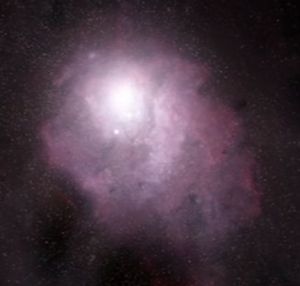
During the service for the dead following the Cylon attack on the Colonies, William Adama states "Life here began out there,"[1] reminding the assembly that this was the first line of the Sacred Scrolls, told to them by the Lords of Kobol uncounted centuries ago. Indeed, the humans of the Twelve Colonies originally lived on the planet Kobol, the purported[2] homeworld of the human race (TRS: "Miniseries").
Much of what is known about life on Kobol is gleaned from the Sacred Scrolls, which makes those accounts potentially unreliable. Purportedly, the thirteen tribes lived in an idyllic utopia with the Lords of Kobol, residing in at least one city, the City of the Gods. What the Scrolls do not tell is that the original twelve tribes of Kobol created the Thirteenth Tribe, a race of synthetic beings with the ability of organic memory transfer, allowing their bodies to die but their consciousnesses to download into a new body (TRS: "No Exit").
Exodus
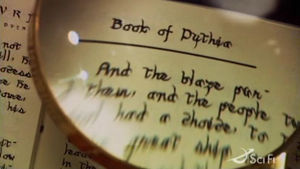
The Book of Pythia, recorded by the oracle Pythia on Kobol 3,600 years before the destruction of the Colonies, detailed the exile and rebirth of the human race (TRS: "The Hand of God"). It is not known whether or not this book was a true prophecy predicting the destruction of the Twelve Colonies or a recitation of events on Kobol. Regardless, the book was written in the midst of great turmoil on Kobol.
The prophecy alludes to a "blaze" which descended on the thirteen tribes and against which the Lords of Kobol were powerless to intervene (TRS: "Home, Part I").[3] The Thirteenth Tribe fled Kobol roughly 4,000 years before The Fall, settling on a planet called Earth.

Approximately 2,000 years later, the remaining twelve tribes also left Kobol. According to the Sacred Scrolls, the populace of the tribes were taken in a "Galleon" (a spacecraft). Athena, a Lord of Kobol, threw herself from the Gates of Hera, to her death. The leaders of the tribes were interred with her, and Zeus warned the survivors that any return to Kobol "would exact a price in blood." After a journey through space, the refugees from Kobol founded the Twelve Colonies of Kobol.
Settlement
After settling on their new homes, another cataclysm befell the Twelve Tribes. This resulted in the destruction of much of their knowledge base and sent the Colonies into a dark age [4][5].
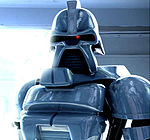
After their return to space, the Colonies established many observatories, listening posts, research stations and armories in their system. Inequity and war were common between the Colonies for most of this time period as each colony behaved more as sovereign nations. By the end of the strife, Sagittaron had been exploited for centuries (TRS: "Bastille Day").
Various shifting alliances and attempts at unified government came out of these conflicts, which would later form the bedrock of the Articles of Colonization, but it would still be some time before a practical Colonies-wide government was established [6].
The Colonials also created robots, called Cylons, to do work which they found unpleasant, including industrial work and soldiers in their civil wars.[4]
The Cylon War
- Main article: Cylon War
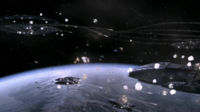
Such was the extent to which the Colonies had invested their military power in the Cylons that when they chose to rebel against their masters, the Colonials found themselves well-matched. With their mastery of Colonial technology, the Cylons were able to infiltrate nearly all networked devices. The Colonials were forced to abandon networked computers and wireless devices in favor of more secure and durable technologies, able to withstand both Cylon infiltration and the powerful nuclear weapons used by the warring parties[7]. Twelve battlestars built in the opening years of the war best exemplified these principles, including Galactica (TRS: "Miniseries"). In response to the great threat posed by the Cylons, the Twelve Colonies formed a unified federal Government for the first time, at the beginning of the war (TRS: "Colonial Day").
At its darkest hour, the Cylon War came very close to wiping out the Colonies.[4] This outcome of the war likely developed, among other practices, the Case Orange contingency government succession protocol as well as the re-buildup of the Colonial Fleet in the Federal Era.
Armistice
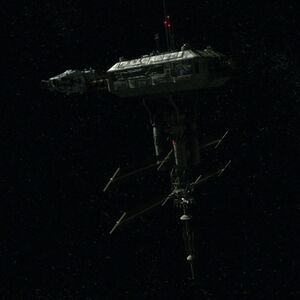
After the Cylon War ended in 40 BCH (60YR), a long and bloody struggle of approximately 12 years, an armistice was declared, and the Cylons departed for a world of their own. The Colonials established a neutral meeting place, Armistice Station, and made diplomatic overtures for Cylons and Colonials to meet annually. However, these overtures were continually ignored.
After the war, the military went through a Reduction in Force, resulting in the discharge of many of the war's veterans.
Federal Era
While the Cylon War had a lasting effect on the government of the Twelve Colonies, the population as a whole, much of it born after the war, had relegated it to a historical note in textbooks[8]. The now-united government continued to maintain a large standing military, which, forty years after the war, had grown to include 120 battlestars (TRS: "Miniseries"), most apparently more advanced than those of the original battlestar class (TRS: "Pegasus"). This buildup apparently began about twenty years after the war, around the time Saul Tigh and William Adama rejoined the military ("Scattered" and its podcast).
With their military assets now concentrated in a central government under the Articles of Colonization (with Caprica City as the capital), the new government of the Twelve Colonies was able to maintain peace among its members (TRS: "Water"). Now presumably free of the Cylon threat, technologies which could not be used during the war were redeployed throughout the fleet, increasing its effectiveness against more mundane opponents (TRS: "Miniseries").
This new era of federalism was not without considerable opposition. Dissidents on Sagittaron lead by Tom Zarek took arms against the government (TRS: "Bastille Day"), supplied by arms dealers like Leoben Conoy.[4] Regardless of these localized attempts at insurrection, on the whole the Twelve Colonies faced no major military threats, with the loss of contact with the Cylons. The Colonial Fleet's standing numbers were actually kept disproportionately high relative to their common uses, in fear that one day the Cylons might return. Day-to-day work for the Fleet consisted of handling the small-scale brush fire attempts at rebellion such as on Sagittaron, but these were all light peacekeeping actions rather than actual fighting. Prior to the Cylon attack, none of Galactica's younger-generation crew had ever seen any real combat.
Fall of the Twelve Colonies
- Main article: Fall of the Twelve Colonies
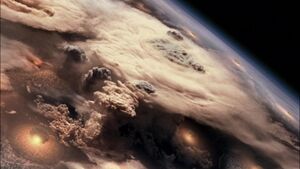
The arrogance of the Colonials in re-equipping their military with technologies vulnerable to Cylon interference proved to be their undoing. The Final Five residing among the Colonials became a target for revenge for the creation of the seven humanoid Cylon models in their image. In 0 BCH (2000BYR), forty years after the first Cylon War, Cylon infiltrators subverted Dr. Gaius Baltar's Command Navigation Program, allowing an advanced Cylon armada to destroy the Colonial fleet with impunity.
The attack resulted in the nuclear bombardment and occupation of the Colonies and the enslavement of most of the few isolated survivors in a series of Farms. Altogether, less than one hundred ships (mostly civilian) survived the attack, including only two battlestars - the nearly obsolete Galactica and the Mercury class battlestar Pegasus. The survivors abandoned the Colonies and formed a fleet in search of the thirteenth colony, Earth, where they hope to find refuge. However, Earth turned out to be a nuclear wasteland. It was revealed that the thirteenth tribe was entirely Cylons, and Earth was an all-out Cylon colony.
Settlement of the new Earth
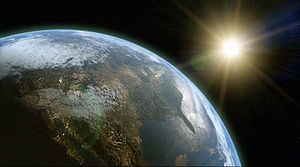
Despite the discovery that Earth could not sustain human life, the Colonial fleet soon found another inhabitable planet, which they christened Earth in a symbolic homage to the original planet. They discovered that, despite the impossibly small odds, another group of primitive humans had naturally evolved on the planet.
In a collective decision, the survivors chose to surrender their technology by sending their fleet into the Sun; they then dispersed in groups across the planet. Though some cultural memes of the Colonies survived, such as belief in the Lords of Kobol in the form of the Greco-Roman pantheon, maintaining the history of humanity proved impossible without technology. By the time an advanced society reemerged on the planet nearly 150,000 years after settlement, the knowledge of Kobol and her Twelve Colonies had been lost. Even the fate of the star system of the Twelve Colonies, Cyrannus, was not revealed.
References
- ↑ This line is an homage to the Original Series, where each episode began with a voiceover of this phrase.
- ↑ Given the repeated theme of eternal return and Roslin's claim in Kobol's Last Gleaming that the cycle of time had no beginning, it is possible that Kobol is not the true homeworld of humanity, but merely another settled planet in an eternal cycle of exodus and settlement
- ↑ In a scene cut from the episode "Kobol's Last Gleaming, Part I," Elosha states that the exodus from Kobol was precipitated when "one jealous god began to desire that he be elevated above all the other gods, and the war on Kobol began." In another deleted scene cut from the episode "Fragged," Roslin states that humanity wasn't "exiled" from Kobol, but that the Sacred Scrolls say that "there was some sort of battle among the Gods, and when it was over we chose to leave."
- ↑ 4.0 4.1 4.2 4.3 RDM, January 30, 2005).
- ↑ On the real-world Earth, similar dark ages occurred after the falls of Rome and Mycenaean Greece, and lasted for centuries. It is possible that much of their technological knowledge of interstellar spaceflight was lost after the escape from Kobol. Over time, they rebuilt their technological base, and travel between the Colonies was commonplace for some time before the Cylon Attack.
- ↑ RDM, April 11, 2005).
- ↑ RDM, January 19, 2005).
- ↑ much as real-world Earth citizens regard their Second World War